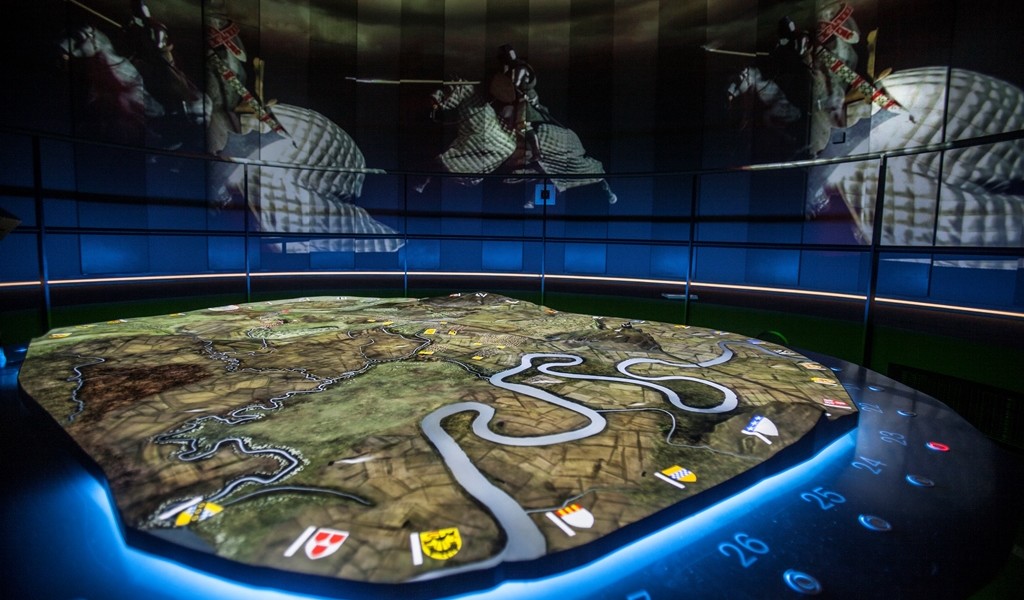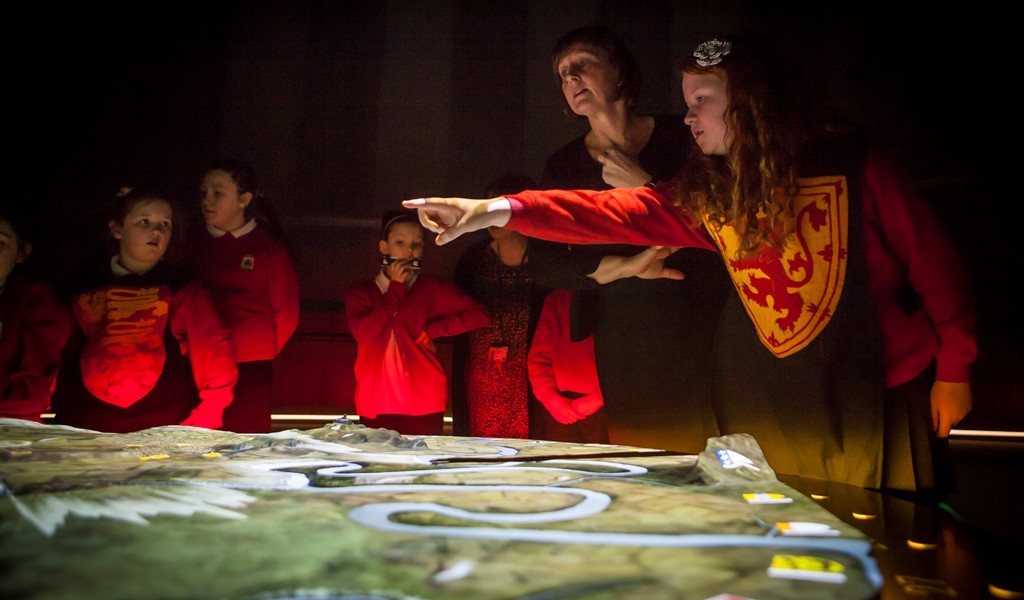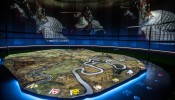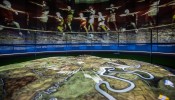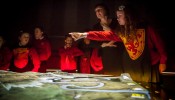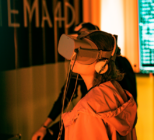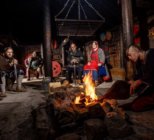The Battle of Bannockburn’s immersive visitor experience designed by Bright White has won acclaim for innovation including scooping a Museums + Heritage Award for that category in April, but more importantly, Bright White say, it has also been recognised at the highest level for excellence in interpretation generally. The company developed the idea of engaging the audience in a pivotal battle in the Wars of Scottish Independence, and using blended reality technologies to achieve the desired results.
“We would advise caution in concluding that Bannockburn is a hit with visitors because it involves technology; the visitor surveys strongly show that it is popular because it gives the audience agency – it is their fight, and the battle will be won or lost on their efforts,” says Chris Walker, Bright White’s managing director.
The BattleRoom is designed to accommodate groups of 30 participants with another 30 observers in a Colosseum-style combat arena where participants are divided into two teams, representing the belligerent armies of Edward II and Robert Bruce, and fight it out in a tactical and strategic battle simulator.
With authenticity and historical accuracy a high priority, visitors command one or more divisions to defeat or victory. Lasting typically 30 minutes, each battle is facilitated by a member of staff – the BattleMaster. The terrain map is 3D and animated, resembling a mix between a scale model of the landscape, and a computer game. The events and emotions within combat are supported by surround sound and immersive images.
“Remarkably, the process behind the project was a completely normal public tender with creative pitch, followed by a standard building contract,” says Walker. “The idea of launching the audience into battle was the core of our creative pitch, which I understand won us the contract with the National Trust for Scotland.”
The key to the technical success of the project was Bright White’s robust prototyping and testing regime, which included reporting to the highest level, alongside effective risk management and contingency planning.
If there really is no other way to deliver, or the quality of delivery is demonstrably higher with digital, then we would work with a client to understand the implications of ownership, and assist them to make robust plans to ensure the project continues to deliver, and does not become a liability
“Fortunately, we didn’t need to invoke any of the major contingency plans. The collaboration to deliver the project was immense, including a charity, a government agency, at least two universities, volunteers, many SMEs, and some bigger private companies. Without everybody working to exactly the same goal, this project could not have happened.”
However, Bright White will only consider technology as a solution in museums and heritage attractions if it’s absolutely essential. When given an open brief they will seek to conceive ways to deliver the client’s aims and objectives by all other means first, since digital approaches are usually more expensive and have higher ongoing maintenance costs.
“If there really is no other way to deliver, or the quality of delivery is demonstrably higher with digital, then we would work with a client to understand the implications of ownership, and assist them to make robust plans to ensure the project continues to deliver, and does not become a liability,” says Walker.
Walker believes that digital technology is particularly relevant to the heritage sector as it is a powerful way to deliver targeted content to maximise accessibility. He also says the cultural sector is somewhat behind other sectors in the adoption and exploitation technology, and Bright White want to help put that right.
“We believe that part of Bright White’s role within the industry is to facilitate communication between sectors, and there is one message in particular that is highly relevant to this topic and that is to understand the potential of Virtual Reality,” he says. “First we need to be clear about the term ‘virtual reality’. The word ‘virtual’ in this context (contrary to some web dictionaries and some self-declared authority websites) does not mean ‘nearly’. The true interpretation is carrying the virtues, strengths, qualities and essence of something. We need to stop thinking of virtual projects as being second best compared to the real thing, and start thinking of them as effective constructs from a starting point of nothing.”
In the heritage sector, there are many reasons why the reality in question cannot be accessed by the audience for example if the reality is historical (lost), hostile, protected or physically inaccessible. For this reason VR has the clear potential to provide experiences that are simply not possible by other means.
On the flip side there is whole host of possibilities that VR brings as it is not constrained in the same way as our reality. “Want to fast-forward time? Want to augment your view with information? Want to move instantaneously to a different location? No problem,” says Walker.
When it comes to how important is it for museums to embrace technology Walker says that nobody puts this better than Deborah Bull, director of cultural partnerships at King’s College London, who recently said at a NESTA conference: “[There is a] tension between the responsibility for heritage and the desire to break new ground; too little respect for heritage and the past is destroyed, too much; you threaten the future.”
“Deborah was speaking about the heritage of arts and cultural organisations, and we agree completely,” he says. “Our advice to organisations is to constantly challenge your own practice through adoption of disruptive thinking. If you don’t, someone else will. Technology is providing the opportunity for disruption.”
Recent breakthroughs in technology that have influenced Bright White’s work have emanated from the video game industry. This does not mean everything they do involves a game, says Walker, but that there are technologies relating to natural language processing, character modelling and animation, real-time graphics and lighting, and video image manipulation that are being developed for games that have significant application in the heritage sector. “In 2009 the computer games industry overtook Hollywood in terms of annual production budgets, and the research and development programmes are leaping forward at a fantastic rate,” he says.
Currently Bright White are nearing completion of an important project with the National Holocaust Centre, where they have been developing mixed reality technologies relating to Holocaust testimony, which is a collaboration researchers in the UK and US.
Each day, a survivor of the Holocaust speaks for an hour at the Centre, and then invites questions. This has been happening for nearly twenty years. The survivors are now in their 80s and 90s. Today’s sessions provide the audience with the opportunity to ask the survivor questions and receive an answer. “Looking to the future, we have developed a method of filming, processing and representing the survivors and their testimonies, and enabling a virtual Q&A session that means that audiences will forever have the opportunity to ask questions of survivors and get an answer,” he says. “We have filmed nine survivors so far, asking them each 1,100 questions over an intensive week each in the studio. The computer software developed to enable the interaction with a survivor has two cutting edges, in the matching of questions to answers, and in the ability to switch realities in playback.”
The project is due to conclude in the second quarter of 2016, and the collaboration have set up a dedicated project website.



